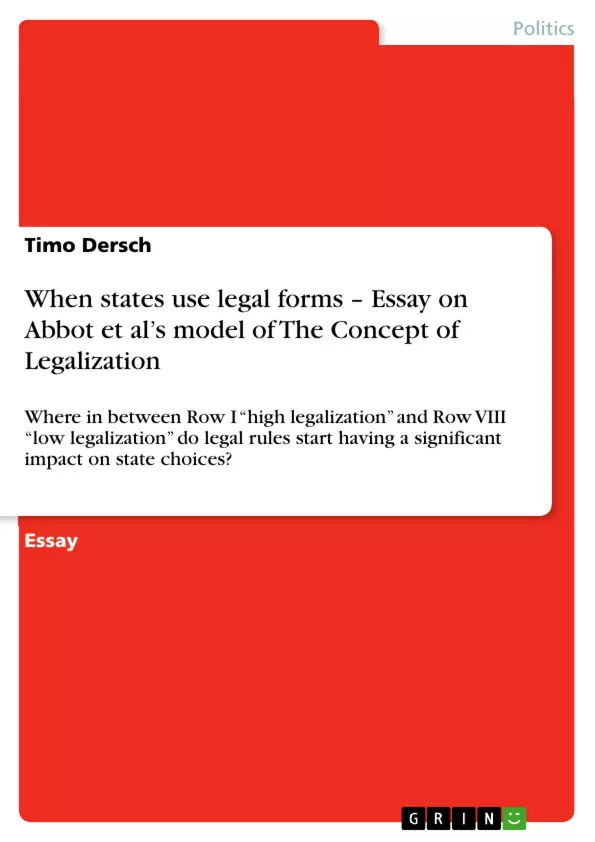Abbot et al divide the term of legalization into three criteria to create a model with which
Political Scientists and International Lawyers could be able to measure and differentiate
different legal statuses of international agreements. The division into the variables obligation,
precision and delegation shall provide the ability to score international institutions on the
different characteristics according to whether the characteristic may or may not be possessed.
Through the scoring of “High” or “Low” in each of the three categories, a possible outcome
of eight different forms of international institution legalization is given. Starting from Row I,
in which all three categories are scored with “High” and which is referred to with the term
“Hard law”, Table 1 (p.406) shows all the possible combinations, ending with row VIII which
presents the softest form of commitments. The authors identify the edges of the graphic as
ideal types, on one side the hard law and its full legislation, on the other side an anarchical
state, still organized by institutions as sovereignty and diplomacy, but operated by principles
as the balance of power or spheres of influence. For each stage Abbot et al state examples that
might fit into the actual category. [...]
Inhaltsverzeichnis (Table of Contents)
- The Concept of Legalization
- A Discourse on Significant Impact
- Critique of the Model
Zielsetzung und Themenschwerpunkte (Objectives and Key Themes)
This essay aims to analyze Abbot et al.'s model of legalization and determine at which stage legal rules begin to significantly impact state choices. The author examines the model's variables of obligation, precision, and delegation and explores the relationship between legal institutions and state decisions.
- The impact of legal rules on state choices
- The three variables of legalization: obligation, precision, and delegation
- The hierarchy and interdependence of the legalization variables
- The role of time in the process of legalization
- The limitations and potential improvements to Abbot et al.'s model
Zusammenfassung der Kapitel (Chapter Summaries)
- The Concept of Legalization: The author introduces Abbot et al.'s model of legalization, which utilizes three variables (obligation, precision, and delegation) to classify international institutions and their legal status. The model identifies eight possible forms of legalization ranging from "hard law" to "soft commitments."
- A Discourse on Significant Impact: The author explores where in the model legal rules begin to have a significant impact on state choices. Starting with the "softest" forms of legalization, the author analyzes examples such as spheres of influence, balance of power, and the G7. They argue that these examples lack sufficient legal character to influence state decisions significantly.
- Critique of the Model: The author identifies several shortcomings in the model, including the vagueness of the "High" and "Low" scoring system, the lack of a hierarchy among the variables, and the absence of a time dimension. The author also suggests potential improvements to the model, such as incorporating more scoring stages and a fourth category to measure the progress of legalization over time.
Schlüsselwörter (Keywords)
The main keywords and focus topics of this essay are: legalization, international institutions, state choices, obligation, precision, delegation, hard law, soft law, Abbot et al.'s model, critique, limitations, improvements.
- Quote paper
- Timo Dersch (Author), 2012, When states use legal forms – Essay on Abbot et al’s model of The Concept of Legalization, Munich, GRIN Verlag, https://www.grin.com/document/206095



